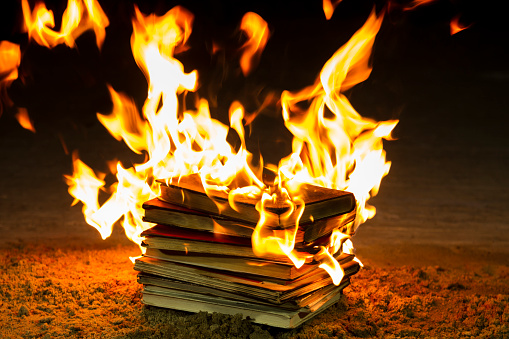BOOKS ARE THE ULTIMATE SURVIVORS!

Ancient as well as modern history is replete with instances where books not only faced bloody carnages, but also blazing pyres, tyrannical regimes, banishments and the onslaught of technology. Yet, they have managed to survive, to this day. For those sceptics who think books will not be able endure the e-wave, here’s an apt response by Stephen Fry,
“Books are no more threatened by Kindle than stairs by elevators.”
Fire has been the oldest and the most common cause of destruction of books, known to mankind. From inadvertent burning to consigning them to bonfires, books have endured it all. Incidents like the destruction of the Library of Alexandria in which books were engulfed by the lapping tongues of fire are not rare. Historians allege that while Caesar was on his way to conquer Egypt in 48 BCE, he set fire to the city which unfortunately consumed the ancient library, too, in its wake. It is believed that at its peak, the library housed a collection of over 400,000 scrolls which were lost to humanity. Similarly, the burning of the Maya Codices led to the destruction of all the available records of the pre-Columbian Mayan Civilization. These were folded bark paper books that housed invaluable knowledge. They were burnt by the Spanish Friars in the 16th century in order to annihilate the Mayan culture.
Back home, the destruction of the Nalanda library set up in the Nalanda Monastery in the 5th century CE was a huge setback as it boasted of a priceless collection of hundreds of thousands of books on history, religion, arts, science, astrology, literature and language among other subjects. Unlike the above examples, it was not burnt down but razed to ground by a general of the then-ruling Delhi Sultanate in 1193 CE.
While burning of libraries, deliberately or accidentally, is tragic; mass burning of books in bonfires has been a time-established trend of cultural censorship, also known as cultural genocide. The first example available in the annals of history is from the Qin Dynasty of China when in 213 BCE Emperor Qin Shi Huang ordered the burning of books and burying alive of the 460 Confucian scholars.
The 16th and 17th centuries witnessed similar bonfires, though sporadic, during the reign of Henry VIII, who broke away from the Catholic Church to establish the Protestant Church in England. He instigated the Protestants to burn every religious book based on Catholicism, vandalise the churches and even encouraged the general public to witness the ‘spectacle’.
The last century, of course, witnessed the massacre of books in the form of book burning events organised by the youth wing of the Nazi party in Germany when cartloads of books of authors, philosophers and poets, whose lists were prepared, circulated and pasted at public places by the government officials were brought at designated places and huge bonfires engulfed works of indispensable worth. Marcus Zusak’s modern-day classic, The Book Thief, is based on the book burning events in the Nazi regime.
Banishment of authors and their works is another form of violence perpetrated upon the intellectual world. Litterateurs have always been on the anvil of hate mongers and authoritarian regimes. Salman Rushdie, D. H. Lawrence, James Joyce, Nadine Gordimer, Gustave Flaubert and Toni Morrison are some of the names whose works have borne the brunt of intolerance.
It’s now time for the books to face the greatest challenge of their times- digitalization. However, bibliophiles like me, are hopeful that books cannot die. They have been survivors and will continue to do so despite every challenge for it is said,
‘Difficult roads often lead to beautiful destinations.’















